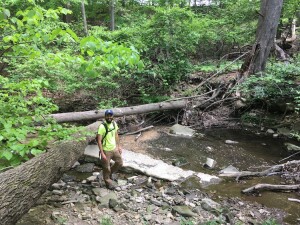Urban Geomorphology and Water Quality
Ongoing Work
Much of our current work on fluvial geomorphology focuses on the distribution and effects of anthropogenic debris and plastics in urban streams. Read more about that here.
Sediment transport in urban streams is highly relevant to water quality and erosion concerns. For example, in the Lake Champlain Basin, phosphorus yield per acre is higher in urban areas than in agricultural areas. Much of that phosphorus likely moves into the lake bound to sediment moving in streams. Sediment transport from bank or bed erosion is a natural geomorphic process of dynamic fluvial systems, but in urban areas such erosion may also jeopardize infrastructure. Fine sediment also has effects on biofilm growth and other ecological functions. For all of these reasons, we are working on sediment transport as a key component of geomorphic processes and water quality in urban streams, in work that ties tightly to our on-going research on stormwater management. PhD student Suffiyan Safdar is leading the way through thematically connected projects in Cleveland (Ohio), Burlington (Vermont), and at the national level.
- Safdar, S., Jefferson, A.J., Costello, D.M., Blinn, A. 2024. Urbanization and suspended sediment transport dynamics: a comparative study of watersheds with varying degrees of urbanization using concentration-discharge hysteresis. ACS ES&T Water, 4, 9, 3904–3917, doi: 10.1021/acsestwater.4c00214.
Our recent and upcoming work also touches on other water quality and ecosystem function components, including phosphorus and ecosystem metabolism.
- Blinn, A.J., Jefferson, A.J., Bhaskar, A.S., Hassan, Z.U., Safdar, S., Costello, D.M. in review. Stream metabolism response to storm flow in urban watersheds near Cleveland, OH and Denver, CO.
Recent Projects
If a tree falls in an urban stream, will it stick around? MS student Garrett Blauch investigated the abundance, mobility, and geomorphic effects of large wood in urban streams in northeastern Ohio. His work showed that wood abundance decreases – and mobility increases – as a function of urbanization intensity. The high mobility and relative paucity of wood means that it exerts only limited influence on the geomorphology of urban streams.
- Blauch, G., and Jefferson, A.. 2019. If a tree falls in an urban stream, does it stick around? Mobility, characteristics, and geomorphic influence of large wood in urban streams in northeastern Ohio, USA. Geomorphology. 337: 1-14, doi: 10.1016/j.geomorph.2019.03.033
In many urban hydrology and water quality studies, the percent of the landscape covered by impervious surfaces is the key variable used to explain differences across sites, in part because it is easy to extract from widely available datasets. But watersheds with the same impervious cover can have very different land cover configurations, and we hypothesize that those may lead to heterogenous hydrologic and water quality responses. Graduate student Mary Plauche examined water quality variability in three urbanized headwater stream networks in Summit County, Ohio, focusing on the spatial and temporal variability of chloride and nitrate in these systems with similar impervious cover. She also used nitrate and water isotopes to assess how sources of water and nitrate change during storm events.

